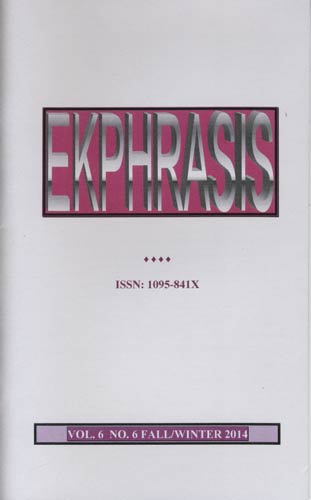Ekphrasis – Fall/Winter 2014
Returning to “Girl Eating a Bird” by Vanessa Zimmer-Powell published in this issue of Ekphrasis is becoming a habit. The language haunts as it depicts, surmises as it reveals. In just ten lines, the poem written after viewing Rene Magritte’s painting, Girl Eating a Bird, exposes more of the painting and its subject. The first line “She chewed open cardinal” evokes in iamb, trochee, and dactyl, a nearly cannibalistic gnaw at the bone. In the next line, in the single syllable “raw,” a reader might feel a twinge of sulfuric delight before reading on to the satisfying end. “She won’t stop / until it is well tasted,” and neither will readers. Returning to “Girl Eating a Bird” by Vanessa Zimmer-Powell published in this issue of Ekphrasis is becoming a habit. The language haunts as it depicts, surmises as it reveals. In just ten lines, the poem written after viewing Rene Magritte’s painting, Girl Eating a Bird, exposes more of the painting and its subject. The first line “She chewed open cardinal” evokes in iamb, trochee, and dactyl, a nearly cannibalistic gnaw at the bone. In the next line, in the single syllable “raw,” a reader might feel a twinge of sulfuric delight before reading on to the satisfying end. “She won’t stop / until it is well tasted,” and neither will readers.
The poems in this issue entreat readers and disclose meaning as a communion between art and the viewer, divulging thematic elements and uncovering overlooked details. In each poem, the voice, authoritative, instructs a particular viewing of a work of art that has become another work of art—the poem. Joseph Stanton’s “Thomas Dewing’s Lady with a Lute” is the proclaimed winner of the 2014 Ekphrasis Prize and wanders through the painting in a progression of three-lined stanzas that lead the reader on a journey that ends “in the lady’s delicate, pale hands—” and where the speaker surmises “the painter wanted to be.” In Elizabeth Knapp’s “The Young Virgin,” the path is through lyrical lines such as “we are / witness to her waiting her // womb an empty vivarium / around her head cherubs- / to-be halo around her” and takes its turns without punctuation around alliterative enjambed lines that seem to end in fulfillment. Each poem suggests and reflects on the viewing experience.
Andrew Pidoux explains, “In galleries you’ll sometimes see / things that don’t belong in galleries,” and the story unfolds to reveal an imprisoned “unicorn in a bluish cabinet / staring out at me as if I wore / something it felt offended by.” The self-conscious onlooker exists in a dreamlike state of surreal impotence. As Pidoux makes Damien Hirst’s “The Dream” known in his single stanza poem, he shows his vulnerability in discovering what is and is not true. The nature of art and what it represents is also explored in Brooke Horvath’s “Winter Wind #2,” in which interpretation is secured by the title and the viewer feels almost bereft of engagement with the piece. So much is revealed in a suggestion of a thought of wind and how, like a Rorschach test, the answer is revealed before the question has had time to formulate. The speaker sees “through a window / that looks out on / other windows, visible because / the wind is not.” The ideas of negative space and signification are proven arbitrary and yet familiar. In each of these two poems, the poets have delivered themselves through the experience of art and come up somewhat wanting and empty yet understanding purpose and function.
Not all works in the issue have paintings or even two-dimensional art as their subjects. The poem, “Voyeurs,” written after viewing the short documentary Vultures of Tibet by Russell O. Bush, transforms a film into verse turning readers into voyeurs watching voyeurs: “We watch each other watch” the carnage available to all on the poet’s list of those who watch, ending with the vultures whose story unfolds as humans observe “a Sky Burial / in the flapping winds of Tibet.” The poet, Jodi Hottel, exposes the voyeurism of documenting “a tumble of / boiling birds tearing / into flesh,” and all humans as willing to watch and be perhaps not-so-innocent bystanders. The final stanza renders all who watch suspect but human. Focusing on another three-dimensional work, “Exit” by Helga Kidder shares eighteen lines in three stanzas on Mathias Grunewald’s 1512 Isenheim Altarpiece, the visions and colors extant in the panels, changing them into interpretations of the eerie, sacred, and iconic. Her verse explains in the last line: “Each brush stroke a sigh for eternity.” A metaphor for art’s purpose in the world.
As in each issue of Ekphrasis, including this one, the poems are “excellent verse addressing individual works” in a way that includes the reader and draws out the poetry of the visual works of art. Wandering through the pages of this fall/winter issue resembles a visit to a gallery, the visual encased in words, the words rising from the works like the steam off of water, distilled and pure.





